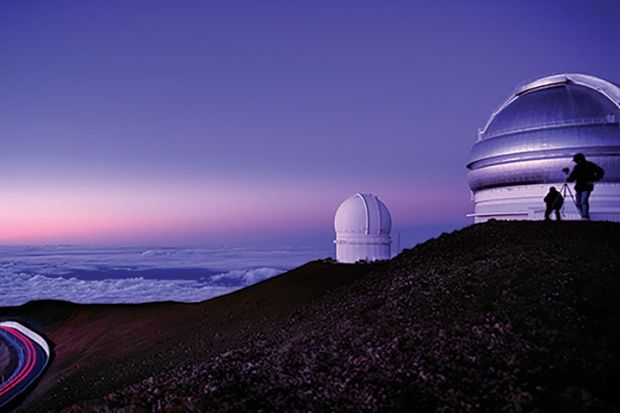Thousands of US astronomers have come to Hawaii and then departed with little optimism that the state will welcome a billion-dollar international telescope project promising profound research advances and a new landmark in US scientific leadership.
The Thirty Meter Telescope (TMT) is a multinational proposal of universities and funding agencies to build one of the world’s biggest visible-light telescopes on Hawaii’s tallest peak, Mauna Kea.
At an estimated cost approaching $2 billion (£1.5 billion), the TMT could give astronomers and the wider world unprecedented views into the universe and offer a leading hope of finding indicators of life elsewhere.
Yet the TMT has been blocked for years by native Hawaiian people who consider Mauna Kea to be sacred ground.
“I am not hopeful about TMT,” Megan Donahue, professor of astronomy and astrophysics at Michigan State University, and president of the American Astronomical Society, conceded after her association’s annual conference this month in Honolulu. “I don’t think there was any tangible progress.”
Project organisers have been battling local opposition for the past decade, winning the necessary permits, including a victory before the Supreme Court of Hawaii. But they and local officials have been reluctant to physically push aside protesters at the site, who at times have numbered in the hundreds.
Scores of protesters spent the second half of 2019 camped out on the main road up Mauna Kea, where a dozen telescopes are now located.
Douglas Simons, executive director of a telescope on Mauna Kea that the University of Hawaii operates with the federal science agencies of Canada and France, admitted that there remained “no clear path forward” in talks over the TMT. The stalemate reflected an “inability to reach across and try to see things through the other person’s eyes,” he said. “There are extreme views on both sides.”
The TMT is competing to be one of three members of the coming new generation of “extremely large telescopes”, which have aperture diameters for their primary mirrors on the order of 30m.
All are international partnerships. The TMT consists of the California Institute of Technology, the University of California and government partners in China, Canada, Japan and India. The US is considering joining through its National Science Foundation if the project moves ahead.
The two other instruments, both already under construction in Chile, are the Extremely Large Telescope, being built by a European consortium; and the Giant Magellan Telescope, by a US-led grouping that includes Australia, Brazil and South Korea.
All are awaited as huge upgrades to the world’s existing visible-light telescopes, which have mirror diameters less than half as big.
According to Professor Donahue, one of the most-anticipated powers of the new-generation telescopes will be a vast expansion in the ability to inspect planet-like objects for telltale signs of life such as gaseous oxygen and ozone, and large amounts of methane.
But with TMT the only telescope planned north of the equator, without it that ability to find life and make other major discoveries would be limited to the half of the universe visible from the southern hemisphere, Professor Donahue said.
The leading candidate site to replace Hawaii for the TMT, if an agreement cannot be reached, is the Canary Islands. That location, however, suffers from problems including high levels of water vapour that would preclude some types of important observations, Professor Donahue said.
Hawaii has set a goal of starting TMT construction by September 2021. But TMT leaders have warned that they will need to make a decision far sooner than that – either beginning work at Mauna Kea, moving to the Canaries or abandoning the project altogether.
Register to continue
Why register?
- Registration is free and only takes a moment
- Once registered, you can read 3 articles a month
- Sign up for our newsletter
Subscribe
Or subscribe for unlimited access to:
- Unlimited access to news, views, insights & reviews
- Digital editions
- Digital access to THE’s university and college rankings analysis
Already registered or a current subscriber? Login








